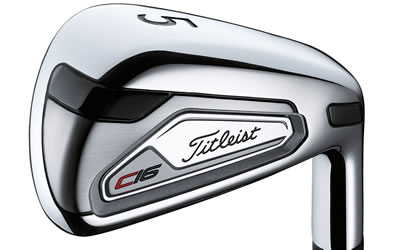
The Titleist C16 irons are long. Really long.
by David Dusek - Golfweek
Modern golf equipment, like most products sold
at retail, is constrained by factors such as price and
manufacturing abilities.
But according to Steve Pelisek, Titleist’s
president of golf clubs, the Fairhaven, Mass.,
company wanted to give its designers a chance to go
wild. With no worry about anything except function,
what would they make? Dream it up now, worry
about how to make it later. From such directives, the
Concept Initiative was born.
“The new Concept products are products
that were advanced research, and we believe they
are breakthroughs that will eventually work their
way into our global product line,” Pelisek
said. “We wanted to create a way, a platform,
between those two steps in time.”
Pelisek was quick to point out that Concept
items are not experiments, but clubs that use new
materials, processes and technologies. They will not
be considered “in-line” products and
Pelisek said the Concept products will not change
Titleist’s two-year product cycles.
They probably won’t ever be seen in the
bag of a PGA Tour player either, and because
Concept clubs are going to be sold in such small
quantities, they are not going to make a meaningful
contribution to Titleist’s bottom line, either.
In reality, the Concept creations can be
compared to an automaker’s concept cars:
They give an idea of what engineers are dreaming
the future might hold.
TITLEIST C16 IRONS
The C16 irons are made with four materials and
a goal to increase carry distance. On the 4-iron
through 7-iron, a cast 17-4 stainless steel body is
fitted with a forged K301 stainless steel cup face that
is only 2 millimeters thick. The face is lighter than
normal, and because the body is hollow, it can flex
more easily at impact to boost ball speed and
distance.
“We’ve been making forged irons
for years and years, but we’ve never had a
hosel-face cup construction like this before,”
Stone said. “This is a first for us, and quite
frankly, we don’t know of anyone who has
done it quite this way before.”
The 8-iron through pitching wedge are made
with 1RK95 stainless steel.
Pelisek said the unsupported face area is 7
percent larger on the C16 4-iron than on the716 AP1
4-iron.
Inside the 4- through 7-irons, Titleist added 98-
grams of weight in the form of a pair of tungsten
pieces. Stone said that’s more than double
the amount of tungsten found in the 716 AP1 irons.
Most of that weight is in the toe, but there is a
small piece in the heel, too. All that weight makes
the C16 irons extremely stable without making the
heads too large. From a size perspective, the C16
irons are larger than the 716 AP2 but smaller than
the 716 AP1.
Stone said that compared to the 716 AP1, which
had been Titleist’s longest-hitting iron to date,
the C16 irons averaged 7.8 more yards carry
distance with a 4-iron.
“We’re on our fifth generation of
the AP1,” Stone said. “We’ve
incrementally improved the AP1, but this is a giant
leap. It’s a completely different leap for the
iron category.”
Just 1,000 sets will be made, and they will be
sold exclusively at the Titleist Performance Institute,
the Manchester Lane Test Facility and at Titleist
Fitting Days. Numerous shaft opinions will be
available. A set of eight irons (4-gap wedge) will
cost $2,699 in steel and $2,999 in graphite.